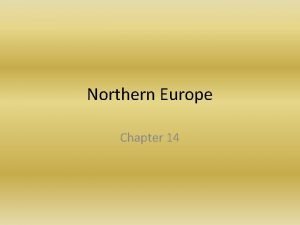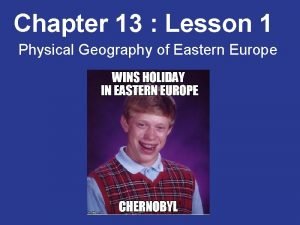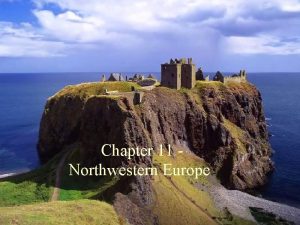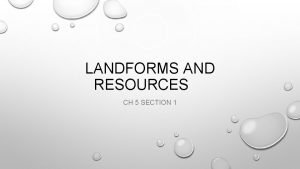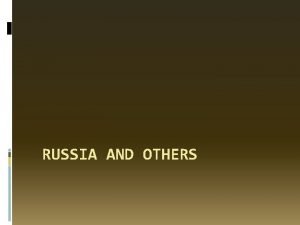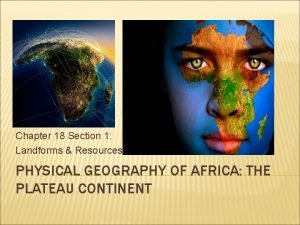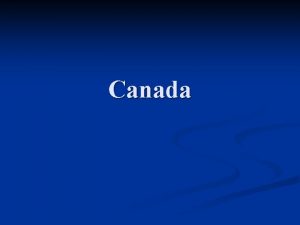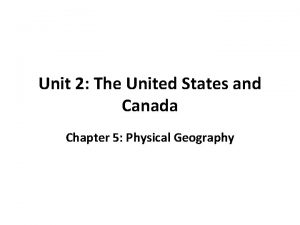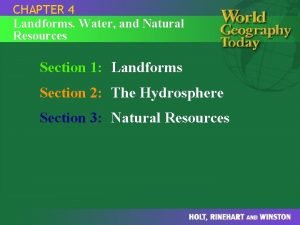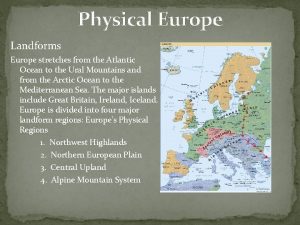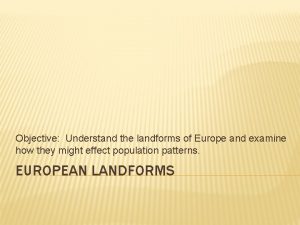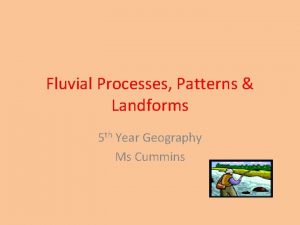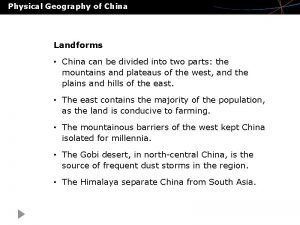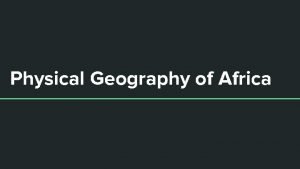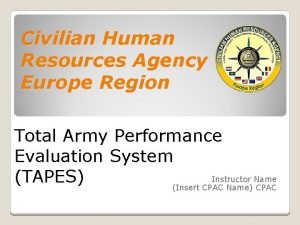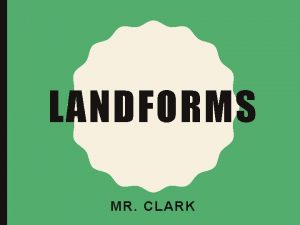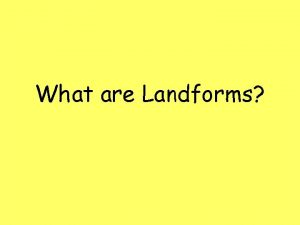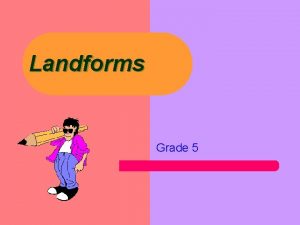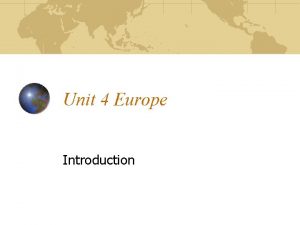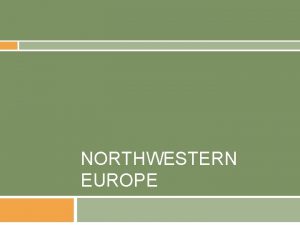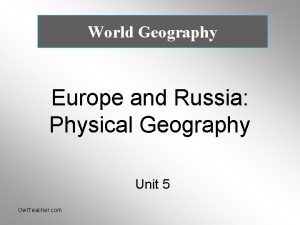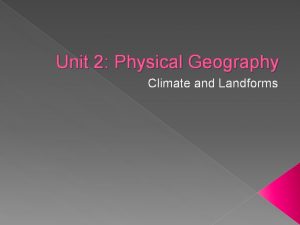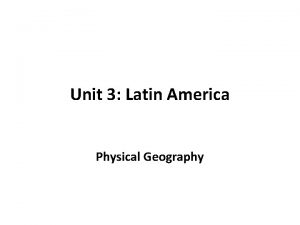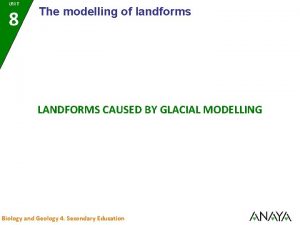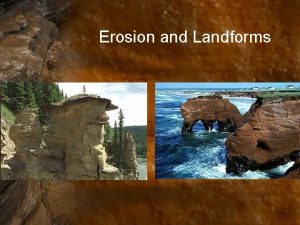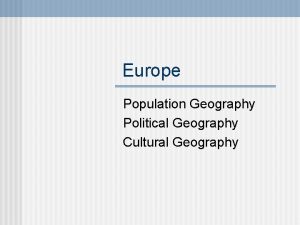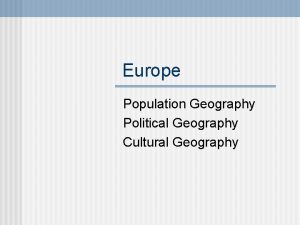Unit 4 Europe Physical Geography Landforms and Resources





















- Slides: 21

Unit 4: Europe Physical Geography

Landforms and Resources

Peninsulas and Islands • Northern Peninsulas – Scandinavian Peninsula: Norway and Sweden – Carved out by glaciers • Fjords-steep valleys that connect to the sea – Jutland Peninsula: Denmark and a little bit of Germany

Peninsulas and Islands • Southern Peninsulas – Iberian Peninsula: Spain and Portugal – Italian Peninsula – Balkan Peninsula • Islands: – Great Britain, Ireland, Iceland, Greenland

Mountains and Uplands • Mountain Chains – Alps – Pyrenees – Apennine – Balkan

Mountains and Uplands • Uplands – Hills, low mountains, contain ancient mountain ranges – Meseta – Massif Central

Rivers • Used to transport goods and people • Danube and Rhine have been a highway for centuries • Historically, these rivers have connected Europe to other parts of the world

Plains • Northern European Plain stretches across: – France, Belgium, Netherlands, Denmark, Germany, Poland. – Great agricultural area – Has been a detriment in the past due to it being easy to invade

Resources • Energy – Oil and natural gas – North Sea • Agricultural Land – 33% is suitable for agriculture – Grains – Grapes – Olives – Cork – Timber

Climate and Vegetation

Westerly Winds • Marine West Coast Climate • North Atlantic Drift-current of war water from the tropics, flows near west coast • Westerlies (wind) blow west to east, pick up warmth from North Atlantic Drift and carry it over Europe

Conditions Inland • Westerlies do not benefit those living farther inland • Sweden, Finland, Poland, Slovakia, Hungary have a humid continental climate – Cold, snowy winters – Warm, hot summers

Mediterranean • • • Southern Spain through Italy and Greece Summers are hot and dry, little rainfall Winters are moderate, rainy Mistral-cold, dry wind from the north Sirocco-hot, steady wind from the south

Land of the Midnight Sun • Along the Arctic Circle – Tundra climate – Winter nights are extremely long, but so are summer days – Sometimes in winter: sun never rises – Sometimes in summer: sun never sets

Human-Environment Interaction

Polders • Land reclaimed by diking and draining – Because Dutch needed more land for growing, they reclaimed land from the sea

Polders • Seaworks-structures used to control sea’s destructive impact on humans – Dikes-hold water back – Terpen-earthen platforms, used as a way to go for safety if there was flooding

Polders • Zuider Zee – Arm of the North Sea, now a freshwater lake – Ijsselmeer – Land around the lake was drained, creating more polders and hundreds of sq. miles of land

Waterways as Highways • Venice, Italy and the Canal System – Originally the city was created for those escaping invasion – On the Adriatic Sea, so good for a shipping port

Waterways as Highways • Building the city: – Required unique building strategies: sinking pilings to help support the structures above – Weight of buildings is actually causing the city to slowly sink

Deforestation • Humans have destroyed and damaged much of Europe’s forests due to expansion and other factors • Acid rain and other pollutants are harming the remaining forests
 Scandinavia physical features
Scandinavia physical features Lesson 1 physical geography of the russian core
Lesson 1 physical geography of the russian core Physical features of northern europe
Physical features of northern europe Northwestern europe countries
Northwestern europe countries Chapter 24 section 1 landforms and resources
Chapter 24 section 1 landforms and resources Landforms of the southwest
Landforms of the southwest Landforms and resources section 1 answer key
Landforms and resources section 1 answer key Chapter 27 section 1 landforms and resources
Chapter 27 section 1 landforms and resources Major landforms in russia
Major landforms in russia Chapter 18 section 1 landforms and resources
Chapter 18 section 1 landforms and resources Natural resources in the canadian shield
Natural resources in the canadian shield Chapter 5 section 1 landforms and resources
Chapter 5 section 1 landforms and resources Natural resources from landforms
Natural resources from landforms Europe landforms
Europe landforms Northern europe landforms
Northern europe landforms Eastern europe landforms
Eastern europe landforms Landforms geography
Landforms geography China physical landforms
China physical landforms Physical landforms of africa
Physical landforms of africa What is the transformation process
What is the transformation process Example of fixed resources
Example of fixed resources Da form 7222
Da form 7222
